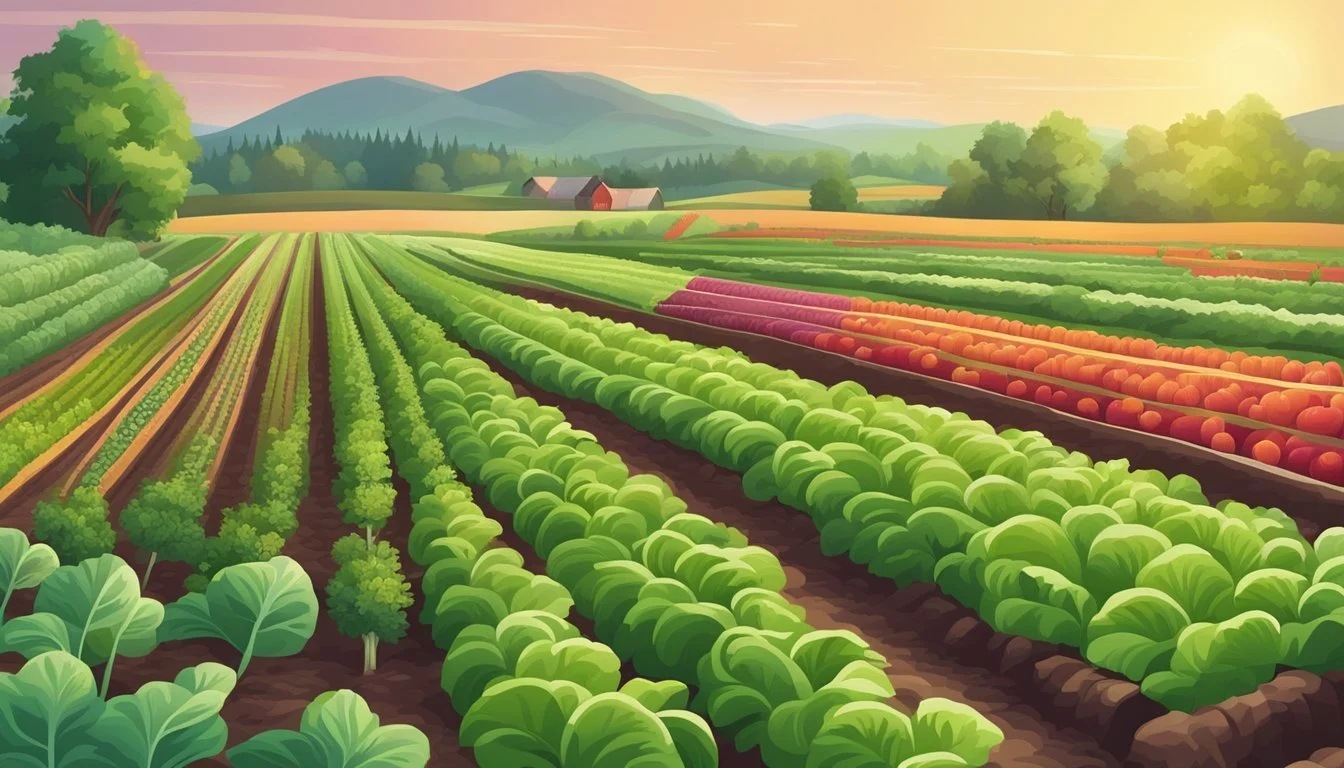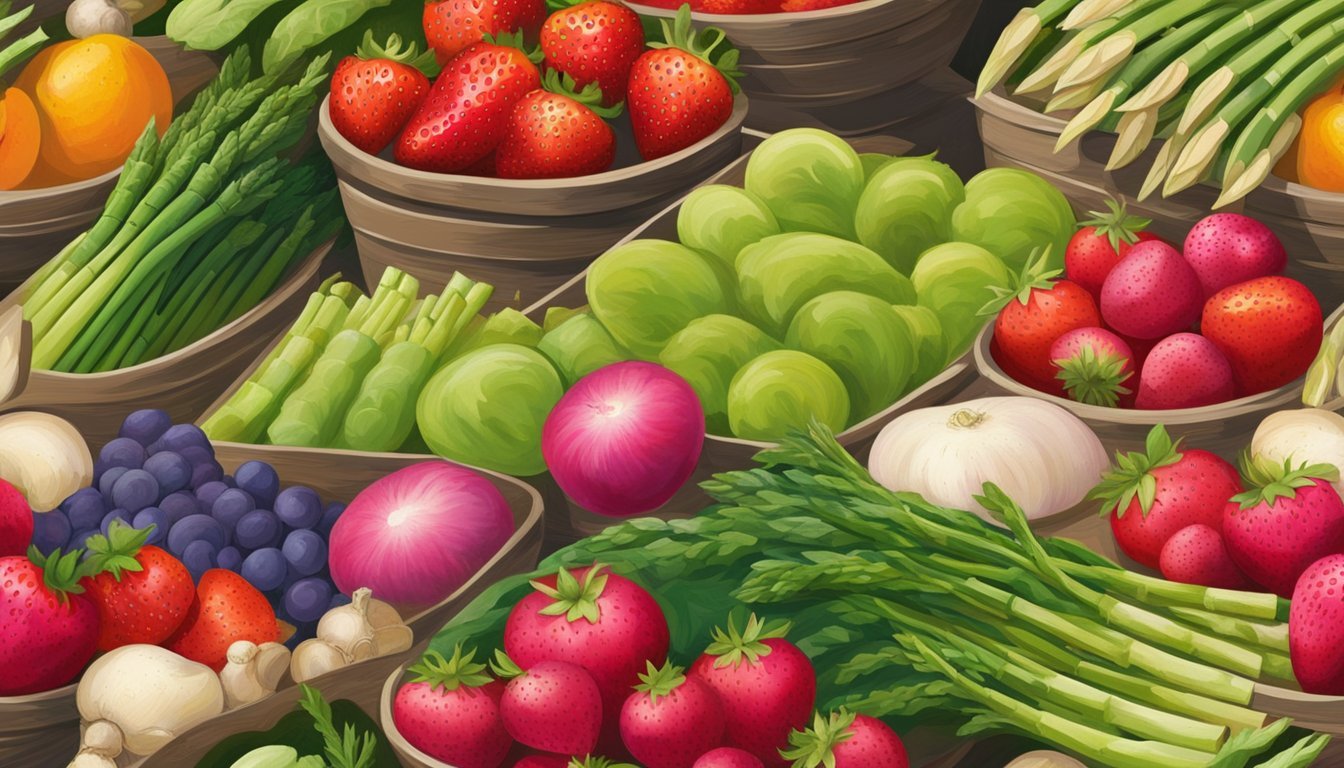Montana Seasonal Fruit & Vegetables in April
A Fresh Guide to Local Produce
This Article is Part of our Montana Seasonal Fruit & Veg Calendar
In Montana, April marks a transitional period within the agricultural calendar, a month where the state's farms begin to awaken from the winter slumber. As snow starts to melt and the days gradually lengthen, the selection of fresh produce available begins to diversify. While the variety of fruits remains limited during this early spring period, root vegetables and greens that have been stored through winter or are quick to grow, like spinach (What wine goes well with spinach?) and radishes, start to make their appearance in local markets.
For those seeking to eat seasonally in Montana, April's offerings might not be as abundant as summer or fall, but there are still plenty of fresh, locally grown vegetables to be enjoyed. Greenhouses and cold frames provide the necessary protection and warmth for certain crops to thrive, thus contributing to the selection of fresh produce. The vegetables that are typically ready to be harvested during this time include leafy greens such as kale and collard greens, which can withstand the cooler temperatures of early spring.
With a commitment to sustainability and support for local agriculture, Montanans can look forward to embracing a selection of fresh, seasonal produce even in the cooler spring month of April. This practice not only contributes to a more sustainable food system but also provides the freshest and most flavorful ingredients for seasonal cooking.
Overview of Montana's Seasonal Produce
Montana's agricultural rhythm is greatly influenced by its climate, with a shorter growing season that has a direct impact on the availability of produce in April. Seasonal eating in this region reflects what is freshly harvested and is often at peak flavor and nutrition.
Significance of Seasonal Eating
Seasonal eating in Montana supports the local economy and promotes sustainable farming practices. It encourages consumers to enjoy produce when it's at its freshest, often resulting in more flavorful and nutritious foods. In April, the emphasis is often on the last of the storage crops and the beginning of spring harvests.
April Climate Influence on Crops
April in Montana brings a transitional climate, as the state moves from cold winter conditions to the milder temperatures of spring. This weather variation is conducive to the growth of cool-season crops. While the fruit selection is limited, vegetables thrive in these conditions.
Vegetables: April's seasonal vegetables often include:
Root Vegetables: Carrots and beets (how long do beets last?) stored from fall
Alliums: Onions and garlic
Leafy Greens: Spinach and kale from greenhouse or cold-frame production
Fruit: Fruit availability is scant, but stored apples from the previous year's harvest may still be accessible.
The focus on these specific types of produce ensures that Montanans have access to fresh, locally-sourced food options even in the early spring months.
Fruits Available in April
In April, Montana offers a limited yet distinct variety of fruits. The cold climate limits early spring growth, but there are still some fruits available during this month, particularly in controlled growing environments or from stored harvest.
Early Spring Fruits
Strawberries: These typically start to become available in late April, though it greatly depends on the weather. If the winter has been mild, they may be available earlier in greenhouses or high tunnels.
Rhubarb: Known for its tartness, rhubarb is often one of the first fruits of the year and is usually ready to harvest in April.
Citrus Varieties
Lemons: While not typically grown in Montana due to the climate, lemons are often available in stores throughout the year, including April.
Limes: Similar to lemons, limes are available in grocery stores but are not locally grown. They remain a staple for culinary uses during this month.
Vegetables Available in April
April in Montana marks a transition period in agriculture, bringing the harvest of cool-weather crops.
Leafy Greens Harvest
In April, leafy greens come into season, providing a fresh burst of flavor and nutrition. Among these, kale stands out for its hardiness and versatility. Gardeners can harvest greens consistently during this time, as they tolerate the still-cool temperatures well.
Root Vegetables and Tubers
April also sees a variety of root vegetables and tubers. Radishes, known for their crisp texture and peppery taste, are often ready for harvest. Gardeners also dig up the last of their potatoes and beets, which have been stored over winter or grown in cold frames.
Cruciferous and Other Vegetables
The cruciferous family, including cabbage and cauliflower, provides robust flavors and numerous health benefits. Cauliflower starts to become available towards the end of the month. In some years, the earliest asparagus (What wine goes well with asparagus?) shoots may be harvested, signaling the beginning of a bountiful season. Additionally, fresh peas can usually be planted earlier and will be ready for harvest, depending on the specific climate conditions of the year.
Preparing and Storing Seasonal Produce
Ensuring that seasonal produce maintains its freshness and flavor requires proper storage and preservation techniques. The specifics can significantly prolong the shelf life and taste of Montana’s seasonal fruits and vegetables available in April.
Storage Tips for Freshness
The key to maintaining freshness and flavor for seasonal produce is understanding the optimal storage conditions for each type of fruit or vegetable.
Beets and carrots should be stored in the crisper drawer of the refrigerator to keep them fresh; however, their greens need to be removed prior to storage to prevent moisture loss from the root.
Lettuce and greens like spinach benefit from being wrapped in a damp paper towel and stored in a breathable bag in the crisper to maintain their crispness.
Mushrooms are best kept in a paper bag in the refrigerator to absorb excess moisture which can help retain their texture.
Parsnips also require cool refrigeration, and like carrots, their tops should be trimmed to ensure longevity.
Preservation Methods
Preserving produce can greatly extend its enjoyment beyond the season. Here are techniques relevant for April’s produce in Montana:
Blanching and freezing work particularly well for greens like spinach, to lock in nutritional value and flavor.
Pickling is ideal for root vegetables such as beets and carrots, which not only extends their shelf life but also adds a flavorful twist.
Drying herbs is a simple preservation method; they should be hung in a cool, dry place until completely moisture-free, then stored in an airtight container.
Each method is designed to maximize the shelf life while preserving the inherent qualities of the produce, including taste and nutritional value.
Health Benefits of Seasonal Eating
Eating seasonally brings a multitude of health benefits. Nutritionally, seasonal produce tends to be at its peak in both vitamins and minerals. For instance, leafy greens harvested in the cooler spring months of Montana are rich in essential nutrients like vitamin C and iron. Flavor is also significantly enhanced in seasonal fruits and vegetables because they are picked at the right time in their natural growth cycle, ensuring each bite is as delicious as it is nutritious.
The health benefits of incorporating seasonal eating habits are extensive. A diet rich in seasonal produce supports the body's immune system and promotes overall well-being. Here are key advantages:
Improved Immunity: Fresh, seasonal fruits and vegetables provide the body with necessary vitamins and antioxidants that boost immune function.
Digestive Health: High-fiber seasonal produce aids in healthy digestion and is beneficial for gut health.
Reduced Inflammation: Seasonal selections often include foods with anti-inflammatory properties, essential for reducing the risk of chronic diseases.
They should opt for a variety of fruits and vegetables to maximize their intake of a wide range of nutrients. Consuming produce like Montana's spring spinach and radishes, which are naturally available in April, is an excellent way to achieve these health benefits. Additionally, seasonal eating often means consuming locally grown foods, which supports local agriculture and reduces the environmental impact associated with long-distance food transport.
Recipes Featuring April Produce
In April, Montana's seasonal produce inspires a variety of dishes, from fresh and zesty salads to comforting meals with hearty root vegetables. The state's short growing season makes the availability of certain items such as asparagus (What wine goes well with asparagus?), peas, artichokes (What wine goes well with artichokes?), and potatoes particularly notable during this time.
Salads and Light Green Dishes
Montana springs to life in April with ingredients perfect for fresh salads and light, green dishes. Asparagus, emerging as a springtime favorite, can be grilled or blanched and added to a salad with a lemon vinaigrette dressing. One might also consider a Pea and Mint Salad, where freshly shelled peas are tossed with mint leaves, olive oil, and a hint of lemon juice for a refreshing side dish.
Grill or blanch asparagus
Combine with mixed greens
Toss in a lemon vinaigrette
Pea and Mint Salad:
Shell fresh peas
Add mint, olive oil, and lemon juice
Toss lightly and serve chilled
Hearty Meals with Root Vegetables
The versatility of artichokes and the comfort of potatoes are showcased in April's heartier recipes. Artichokes can be the star in a rich, creamy Artichoke Risotto, perfectly pairing their distinct flavor with Parmesan cheese and Arborio rice. For a classic, one can't go wrong with Potato Leek Soup; with potatoes melding with the subtle, onion-like leek, enriched with a base of vegetable stock and cream for a satisfying meal.
Artichoke Risotto:
Sauté artichokes and combine with Arborio rice
Cook with chicken or vegetable stock and white wine
Stir in Parmesan cheese before serving
Potato Leek Soup:
Sauté leeks and add cubed potatoes
Simmer in vegetable stock until tender
Blend until smooth and finish with cream
Agricultural Challenges in April
April in Montana presents specific agricultural challenges as farmers ready their fields for planting and early crops begin to grow. Two particularly critical concerns during this time are managing pests and diseases and dealing with temperature fluctuations.
Managing Pests and Diseases
With the onset of warmer days in April, pests begin to emerge in Montana, posing threats to emerging crops. Farmers must be vigilant about:
Monitoring: Regular field checks are essential to identify the presence of pests early.
Integrated Pest Management (IPM): Strategies include biological control using beneficial insects, and when necessary, the careful application of pesticides.
Diseases can also take hold in the damp, cool spring conditions. Managing them requires:
Preventative Measures: These include crop rotation and selecting disease-resistant varieties.
Fungicides: Applied judiciously to prevent the spread of fungal diseases, which can thrive in the unpredictable spring weather.
Effects of Temperature Flacutations
Montana experiences significant temperature swings in April, which can stress plants:
Frost: Sudden frost can damage or kill young plants. Farmers may use row covers or other protection methods.
Heat Waves: Uncharacteristically hot days may necessitate increased irrigation.
The state's climate is characterized by such fluctuations, and farmers must remain adaptable, employing various techniques to mitigate the stress on their crops.
Supporting Montana's Local Agriculture
Purchasing seasonal produce directly supports Montana's local farming community. April in Montana brings a range of cool-weather crops that sustain the state's agricultural economy and provide fresh, nutritious options for consumers.
Local Farming: In Montana, local farmers concentrate on cultivating crops that can thrive during the cooler transitions from winter to spring. They grow a selection of root vegetables and early greens that are hardy against the unpredictable spring weather.
What's in Season:
Root vegetables such as carrots and parsnips
Greens like spinach and various sprouts
Mushrooms, given their ability to grow well in cooler conditions
Community Support: Through community-supported agriculture (CSA) programs and farmers' markets, Montanans have the opportunity to purchase fresh, local produce directly from the growers. This ensures that the financial benefits remain within the state, bolstering the local economy.
Sustainable Practices: Farmers in Montana often employ sustainable practices that are beneficial for the environment. These practices, including crop rotation and organic methods, are instrumental in maintaining soil health and reducing the impact of farming on the local ecology.
Residents can further support these efforts by:
Joining a local CSA program
Shopping at farmer’s markets
Participating in farm-to-table events
Supporting local agriculture is not only an investment in the local economy; it is a commitment to the health and sustainability of the community and the land that makes Montana's agriculture possible.










